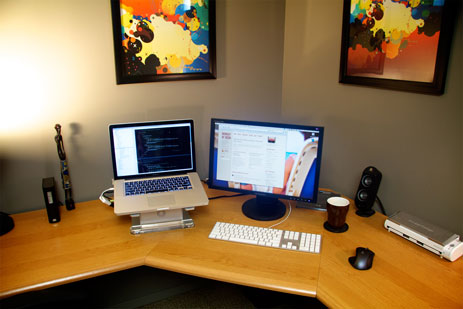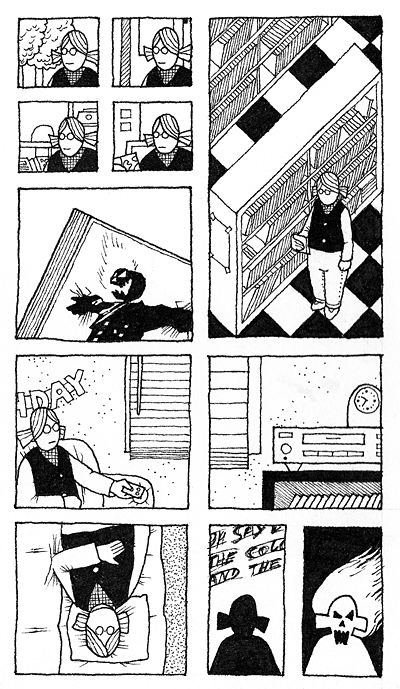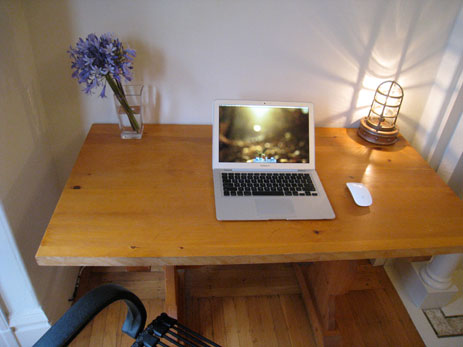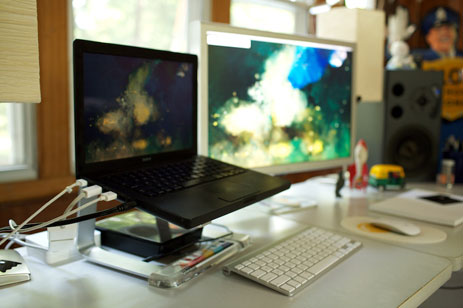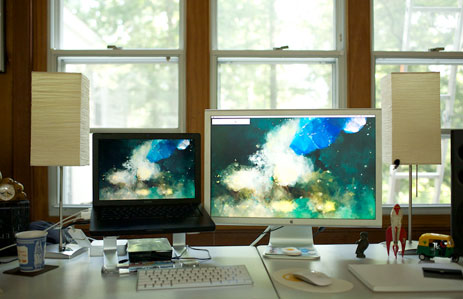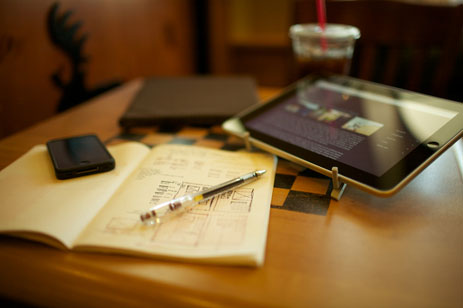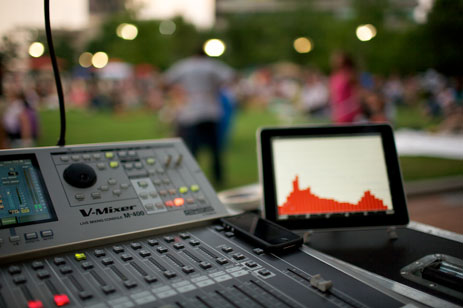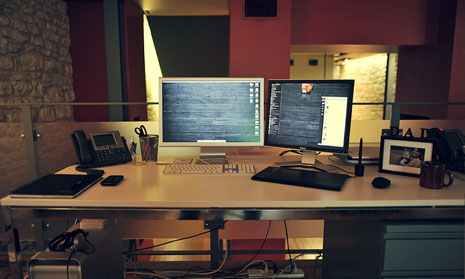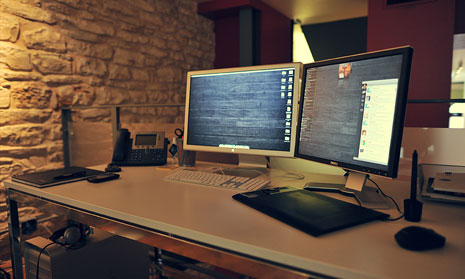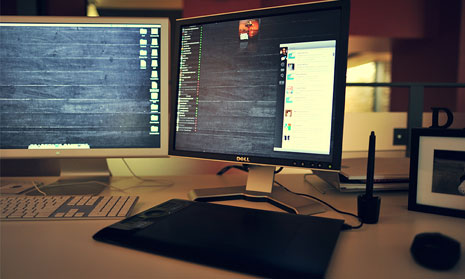Who are you, what do you do, etc…?
My name is Jonathan Christopher, and I’m a Web developer/designer from Albany, NY. I currently spend my days filling the role of Development Director, surrounding myself with writing code, discussing design, site evaluations, and a bit of managerial material along the way.
Perhaps you’ve found yourself at some point reading Monday By Noon, my weekly publication focusing on Web design and development? If not, we’ll need to have a talk.
I try to take photos as much as possible and I’ve got an obsessively long wish list full of gear I’ll never be able to afford, but enjoy thinking and talking about.
I’m recently married and loving every minute of it so far. I’m completely thrilled to be stepping into the next phase of life with my wife. I still get a kick out of saying ‘my wife’ — you can understand.
I also watch at least one episode of Seinfeld per day. Almost.
What is your current setup?
I’m currently using a 15″ unibody 2.66 GHz Intel Core i7 MacBook Pro with 4GB RAM. At home I’m externally connected to a Samsung SyncMaster 205BW, but I wouldn’t mind a 27″ Apple Cinema Display.
- I key with a full-sized wired Apple aluminum keyboard
- I mouse with a Logitech MX Revolution
- I back up to a series of 2TB Western Digital My Book Elites (photos and videos) and 640GB Western Digital Elements (Time Machine)
- I shoot with a Canon 7D (50mm f/1.4, 35mm f/2, 17-85mm f/4-5.6)
Why this rig?
My first Mac was a black MacBook sometime around 2006, and I’ve been hooked ever since. I’ve chosen strictly notebooks since then simply because I work in an office and I truly prefer to be in the same environment both at work and at home. I use external peripherals at both desks which I prefer, but having the ability to go mobile has come in handy on more than one occasion.
What software do you use and for what do you use it?
- Mail.app for all things email.
- iTunes all day every day.
- OmniFocus (and on iPhone) for task management and getting things done.
- 1Password for password management.
- TextMate for every bit of text, code, markup, style, and script I write. I’m even writing this very content in it. I’ve tried everything and always come back to TextMate.
- Fireworks CS5 when designing my own stuff, Photoshop when cutting up everyone else’s. Acorn when I don’t want to wait for Photoshop to start up.
- Yummy FTP when moving sites and assets. Seriously great app; fastest FTP available. Promise.
- ExpanDrive for wonderful network mounted TextMate projects.
- Safari
- Versions for SVN (source control)
- XAMPP for my local development environment.
- Skitch for taking and annotating screenshots. There are lots of apps but Skitch fits my workflow the best.
- Aperture for photo management and post processing. FlickrExport for publishing straight to Flickr.
There’s a bit more but I’m honestly shuffling through these applications every day of my life.
How does this setup help you do your best creative work?
With the combination of mobile hardware along with a tried and tested arsenal of chosen applications, I’m able to focus on the work itself instead of figuring out how I’m going to do it. Not having to worry about software or hardware problems alone helps me get things done, and that can be attributed to being on a Mac running OS X and the software built for it.
The software environment itself also caters to a creative mind. The attention to detail Apple puts forth (as well as software developers) is truly inspirational and sets the bar quite high out of the box. When you’re staring at that in everything you do, you’re inspired subconsciously all day long.
I also try to keep my work environment inspirational as much as I know how. The referenced photo includes a shot of my home office, which I try to keep organized and a bit private. There’s always music playing and it’s always better when heard over speakers instead of headphones. There are two book cases flanking the desk full of not only Web related books but also other books great for leafing through from time to time. Banksy’s Wall and Piece for example is a great piece to revisit from time to time for me. The posters in the background are prints from Joshua Davis, an artist I’ve followed and looked up to for quite some time.
I hope to spend more time on the home office, specifically with my wife as she also has her workstation on the other side of the room. It’ll be a great project for the both of us as time goes on.
How would your ideal setup look and function?
My ideal setup would definitely be in my current home office space, but include a few more details I haven’t had the time (or finances) to pull off quite yet. My wife and I moved into the house (our first home) about a year ago and the office is the last to get attention. It was recently painted Elephant Skin gray and I really like the color, but if I were to change one thing about it I would have to start with the lighting. Lighting is a big deal in an office environment and I’ll be keeping my eyes peeled for a set of lamps to replace the extras I’m currently using.
On a technical level, my ideal setup would include a 27″ LED Apple Cinema Display, completely wireless connections for everything, and wireless electricity. I don’t like wires. I’m supremely happy with my current MacBook Pro and wouldn’t trade that in, but I’d love to see it house a speedy SSD drive should the option come up.
Last, I’d love to have a new series of applications in which to work. Don’t get me wrong, aside from all the quirks here and there I totally love working in Fireworks and TextMate. If I absolutely had to choose two applications to use while stranded on a desert island, they would be it. The issue though, is that the industry has outpaced their development.
TextMate is an open and shut case. The application is truly fantastic but it’s now the job of another publisher to take the torch and continue on. So far, no one has stepped up to the plate as a major player; I’m anxiously awaiting that.
Design software, though, is a different story altogether. Beyond the heated battles surrounding which existing app is better than another, the truth is that no application in existence has been designed to meet the needs of modern Web design. Without getting too philosophical, I’m hoping over the next number of years we see a change in the thought process behind facilitating Web design from the ground up.
More Sweet Setups
Jonathan’s setup is just one in a series of sweet Mac Setups.
